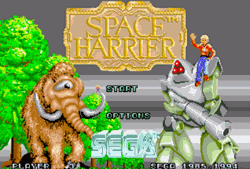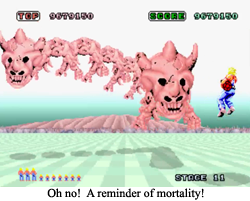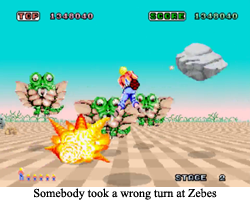 Let’s give credit where credit is due: credits suck.
Let’s give credit where credit is due: credits suck.
Space Harrier is a fun game. At its absolute most “please define this game”, it is a shoot ‘em up of the general fantasy/space variety. However, when you actually grip that special flight stick and start jetpacking around and obliterating dragons, you realize this is something unlike anything else in the arcade. The perspective is “3-D”, a stark change from the other shooters of 1985 and beyond, and there’s just some indescribable something about the sheer rush of adrenaline one experiences when whistling through rapidly scaling rocks and mammoths. Maybe it’s the unusual choice of nixing the typical spaceship or jet and featuring a flying beach bum. Maybe it’s battling absurd and alien monsters that are vaguely enigmatic but wholly murderous. Or maybe, as ever, it’s the moai heads. Whatever the reason, Space Harrier is an incredible experience, even now, as the game approaches its 35th anniversary.
And speaking of things in their thirties, I had the pleasure of playing Space Harrier in my local arcade a number of times as a child. It wasn’t my favorite game (by the time I had a disposable income [my grandfather’s wallet], some certain turtles had already drawn my attention), but Space Harrier held my interest for a number of play sessions. I wasn’t actually any good at Space Harrier, but something told me I should return to that cabinet every once in a while when Magneto or Shredder was defeated. I never saw the final level (let’s be honest, despite the unwavering belief of the adults in my life, I was not actually all that good at videogames as a child), but I did find my way to at least one bonus stage that seemed to reprise the best parts of The Never Ending Story. That was enough for me! Time to go play some Pac-Man before I retire for my afternoon nap.
 But just because I didn’t beat it didn’t mean I didn’t want to beat it. My grandfather’s quarters may have seemed unlimited, but hours at the arcade were at a premium. I only had time for the best of the best, and, let’s face it, how was a game that was already nearly a decade old going to compete with Konami’s The Simpsons? What would have been ideal for a Wee Goggle Bob was a perfect port of that sweet, Space Harrier goodness. Okay, maybe “perfect” was asking for a bit too much. But Teenage Mutant Ninja Turtles 2: The Arcade Game was pretty great! It may have had compromised graphics, but it was still something I could play at home with Jimmy on a Saturday afternoon. And it had two extra levels! Yes! A port of Space Harrier might have had to ditch the delightful graphics and controller of the arcade release, but it would be worth it to finally see the Fantasy Zone conquered if a home port could bring home the action.
But just because I didn’t beat it didn’t mean I didn’t want to beat it. My grandfather’s quarters may have seemed unlimited, but hours at the arcade were at a premium. I only had time for the best of the best, and, let’s face it, how was a game that was already nearly a decade old going to compete with Konami’s The Simpsons? What would have been ideal for a Wee Goggle Bob was a perfect port of that sweet, Space Harrier goodness. Okay, maybe “perfect” was asking for a bit too much. But Teenage Mutant Ninja Turtles 2: The Arcade Game was pretty great! It may have had compromised graphics, but it was still something I could play at home with Jimmy on a Saturday afternoon. And it had two extra levels! Yes! A port of Space Harrier might have had to ditch the delightful graphics and controller of the arcade release, but it would be worth it to finally see the Fantasy Zone conquered if a home port could bring home the action.
Actually, strike that. There was a Master System port of Space Harrier, and it was barely recognizable. It tried to hoist a plot onto this nonsense! You can’t do that, Sega! I want to obliterate skeletal dragons divorced from any sort of stakes! … Oh, also the graphics were terrible.
And, like Nintendo of America, we’re not even going to acknowledge the NES version.
But! Space Harrier did get a “real” port in 1994. By that time, Sega home hardware had progressed to the incredible graphics of the 32X, and we were granted the most accurate port of Space Harrier yet available. And there was much rejoicing! This was distinctly Space Harrier, complete with huge sprites, detailed backgrounds, and that unmistakable feeling of adrenaline as your lil’ dude zooms over the horizon. Maybe dig out an appropriate controller, and this is truly an arcade experience that, after nearly a decade, finally makes it way home.
Except you won’t see anything past the third stage.
 There are eighteen levels in Space Harrier. There are a couple of bonus stages in there, but, aside from that occasional Flammy ride, every thing in every stage is trying to kill you every second. Bosses are bullet sponges, mundane mooks are menacing many minutes, and even inanimate objects are instantaneously fatal at the slimmest contact (though, granted, ol’ Spacey is moving pretty fast). There are no distinct power ups in Space Harrier, so the best you can hope for is temporary invincibility after a lethal collision. A new life grants you a few seconds of sanctuary, but after that grace period is terminated, you could die in every Space Harrier stage literally every five seconds. And suffice to say, if that’s your playstyle, you’re going to need a lot of quarters to see the boss parade finale.
There are eighteen levels in Space Harrier. There are a couple of bonus stages in there, but, aside from that occasional Flammy ride, every thing in every stage is trying to kill you every second. Bosses are bullet sponges, mundane mooks are menacing many minutes, and even inanimate objects are instantaneously fatal at the slimmest contact (though, granted, ol’ Spacey is moving pretty fast). There are no distinct power ups in Space Harrier, so the best you can hope for is temporary invincibility after a lethal collision. A new life grants you a few seconds of sanctuary, but after that grace period is terminated, you could die in every Space Harrier stage literally every five seconds. And suffice to say, if that’s your playstyle, you’re going to need a lot of quarters to see the boss parade finale.
The 32X “arcade perfect” version of Space Harrier offers… five. Five credits. Max.
Not to be constrained by the limits imposed by Sega executives of 1994, your humble author decided to try the real arcade version with unlimited quarters. The results? Even as a seasoned future gamer from the far-flung future of 2019, even as someone who has been playing shoot ‘em ups from birth, even as someone that is a registered cyborg (okay, maybe not really, but I strongly believe that the number of hours I’ve spent with a controller welded to my hands should count for at least partial credit) I still averaged about one or two deaths per level. To be clear, I very much mean “averaged” here, as some of the earlier stages saw me zooming unmolested through the skies as Koschei the Deathless, and other fantasy zones ended with a cavalcade of credit-based corpses scattered across the land. The final stage, a grueling boss gauntlet, was obviously a quarter killer, but, aside from that bit of digital malice, Space Harrier seems like a very doable game with approximately 35 credits. That would be nearly ten bucks worth of quarters in 1985 credits. That, arguably, seems fair.
 Space Harrier 32X allows for five credits. That is about thirty less than I would need. If my mother were playing this wonderful game, that would be about three hundred less than she would need. And that’s ignoring the final boss gauntlet, which, even for a seasoned veteran, would likely require a fiver all on its own. In short: your average player isn’t seeing the end of Space Harrier on five credits. Your average player might not even see the second level.
Space Harrier 32X allows for five credits. That is about thirty less than I would need. If my mother were playing this wonderful game, that would be about three hundred less than she would need. And that’s ignoring the final boss gauntlet, which, even for a seasoned veteran, would likely require a fiver all on its own. In short: your average player isn’t seeing the end of Space Harrier on five credits. Your average player might not even see the second level.
And that’s terrible! Because Space Harrier is good! And, while it is a bit repetitive in general gameplay, it’s still a game that literally never stops throwing new challenges and monsters at the player until the finale. Up to that point, every stage is different from the last, and the difficulty progressively ramps up to compensate for a more confident player. It’s not like Space Harrier ever turns into Battletoads, but greater challenges do wait on later levels.
But the average player would never see those levels. Limited credits meant that a game had to be grinded into a fine paste until a player had the skill to perfectly fly across level after level. And, even if that were achieved, you still only had a handful of lives to conquer the final challenges. That bone-dragon come out of nowhere and wreck your perfect playthrough? Well, welcome back to level one, loser, get ready. You’re doing great (wasting your life)!
 Credits, luckily, have gone the way of the dodo in recent decades. As arcade games (and arcades!) fell out of favor, less and less games seemed to exist to gobble up quarters. Credits were forgotten for loot boxes, DLC, and loot box DLC. Companies found new and exciting ways to fleece customers, usually with items that contain the adjective “rare” (“legendary” is also acceptable). And, ultimately, we’re better for it. A Space Harrier released today might include suspend state saves or infinite credits detracting from the inherent challenge or tension of the experience, but it would allow your ailing granny to actually see Planet Nark and Wi Wi Jumbo. And that’s a privilege everyone should have, regardless of skill, reflexes, or whether or not you own an entire camel full of quarters. Credits are a scourge on allowing someone to enjoy an entire game.
Credits, luckily, have gone the way of the dodo in recent decades. As arcade games (and arcades!) fell out of favor, less and less games seemed to exist to gobble up quarters. Credits were forgotten for loot boxes, DLC, and loot box DLC. Companies found new and exciting ways to fleece customers, usually with items that contain the adjective “rare” (“legendary” is also acceptable). And, ultimately, we’re better for it. A Space Harrier released today might include suspend state saves or infinite credits detracting from the inherent challenge or tension of the experience, but it would allow your ailing granny to actually see Planet Nark and Wi Wi Jumbo. And that’s a privilege everyone should have, regardless of skill, reflexes, or whether or not you own an entire camel full of quarters. Credits are a scourge on allowing someone to enjoy an entire game.
And before anyone wants to tell me that I’m wasting my time, and I may as well be railing against polio or wooly mammoths, let me remind you that Neo Geo emulation with credits is still a thing. A horrible, horrible thing.
Limited credits need to stay firmly in the dustbin of history.
FGC #461 Space Harrier
- System: Arcade and 32X for this review, but it has also appeared on… Didn’t I cover this as part of the article? I am not going to repeat myself! But do pick up the 3DS version! Switch also available!
- Number of players: Space is a great big place that can only fit one Harrier at a time.
- Ready? Many more battle scenes will soon be available !
- Stop Complaining: Yes, the 32X version does have an “arcade mode” code that offers infinite credits. But it requires a second player controller and an immediate stop over at Gamefaqs (or Sega Visions). I’m going to claim that doesn’t count, because I couldn’t be bothered to check for cheats online before playing (now or in the 90’s).
 What’s in a name: Uriah is the fuzzy, white dragon that helps during bonus stages. That is a weirdly biblical name for a magical reptile (or mammal?). David married your wife, dragon!
What’s in a name: Uriah is the fuzzy, white dragon that helps during bonus stages. That is a weirdly biblical name for a magical reptile (or mammal?). David married your wife, dragon!- We’re all friends: The title screen seems to imply that, like Altered Beast, all the characters are friends when the game isn’t in session. All the game’s a stage, and the players merely… players.
- Favorite Boss: For inexplicable reasons, the double skeleton dragon (Salpedon) appears before the single-skulled skeleton dragon (Valda). I don’t know what makes Valda so special, thinking he can show up with a mere one head when his better has already appeared in an earlier level, but that takes guts, and I respect that.
- Did you know? Considering Space Harrier was one of the first 16-bit titles in the arcade, and it used a vaguely analogue-esque “stick” for controls, it would be very appropriate to say Space Harrier was ahead of its time. Considering Space Harrier was released the same year as Commando (not Bionic) and Gauntlet, you can see why Space Harrier’s gorgeous purple skies caught players’ eyes.
- Would I play again: On the 32X? Never. The arcade version (with infinite credits)? That sounds about right.
What’s next? Random ROB has chosen… SoulCalibur 6! And the soul appears to still be burning. Maybe someone should put that out? Please look forward to it!


I think actual infinite credits was an addition only to more recent versions of the game. I distinctly recall the Shenmue arcade version and the port to Wii’s Virtual Console putting a cap on how many times you could continue with your imaginary quarters before the game automatically fails you.
3DS was the first time I ever actually saw the game through to the end.
Double post (no edit feature), but I’m pretty sure 3DS was the first time I beat the game simply because that version offers a level select feature so you weren’t completely screwed over by the game’s stupid built-in three continues limit. Arbitrary credits caps on games you’re already paying to play are bullshit.
Oh well, one thing the arcades still have over mobile is that they could only fleece you for like 25¢ to $1 at a time and you had to go to a place with said machine for them to even do that. I enjoy both Mario Kart Tour and Animal Crossing: Pocket Camp but I am still uncomfortable with the fact that they offer $70 Frivolous Bullshit packages at all. That’s $10 more than the Switch version of Mario Kart 8 Deluxe or next year’s New Horizons!